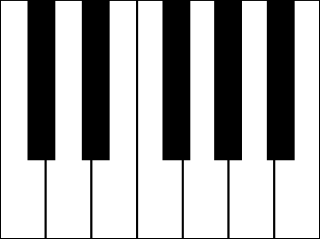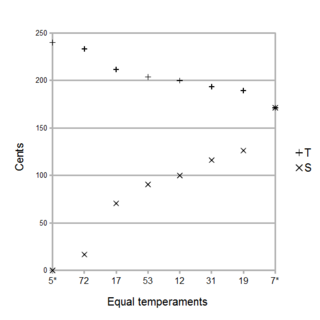Related Research Articles

An equal temperament is a musical temperament or tuning system, which approximates just intervals by dividing an octave into equal steps. This means the ratio of the frequencies of any adjacent pair of notes is the same, which gives an equal perceived step size as pitch is perceived roughly as the logarithm of frequency.

Meantone temperament is a musical temperament, that is a tuning system, obtained by slightly compromising the fifths in order to improve the thirds. Meantone temperaments are constructed the same way as Pythagorean tuning, as a stack of equal fifths, but in meantone each fifth is narrow compared to the perfect fifth of ratio 3:2.

The chromatic scale is a set of twelve pitches used in tonal music, with notes separated by the interval of a semitone. Almost all western musical instruments, such as the piano, are made to produce the chromatic scale, while other instruments capable of continuously variable pitch, such as the trombone and violin, can also produce microtones, or notes between those available on a piano.

In music theory, the wolf fifth is a particularly dissonant musical interval spanning seven semitones. Strictly, the term refers to an interval produced by a specific tuning system, widely used in the sixteenth and seventeenth centuries: the quarter-comma meantone temperament. More broadly, it is also used to refer to similar intervals produced by other tuning systems, including most meantone temperaments.

A semitone, also called a half step or a half tone, is the smallest musical interval commonly used in Western tonal music, and it is considered the most dissonant when sounded harmonically. It is defined as the interval between two adjacent notes in a 12-tone scale. For example, C is adjacent to C♯; the interval between them is a semitone.

In music theory, a comma is a very small interval, the difference resulting from tuning one note two different ways. The word comma used without qualification refers to the syntonic comma, which can be defined, for instance, as the difference between an F♯ tuned using the D-based Pythagorean tuning system, and another F♯ tuned using the D-based quarter-comma meantone tuning system. Intervals separated by the ratio 81:80 are considered the same note because the 12-note Western chromatic scale does not distinguish Pythagorean intervals from 5-limit intervals in its notation. Other intervals are considered commas because of the enharmonic equivalences of a tuning system. For example, in 53TET, B♭ and A♯ are both approximated by the same interval although they are a septimal kleisma apart.

The diaschisma is a small musical interval defined as the difference between three octaves and four perfect fifths plus two major thirds. It can be represented by the ratio 2048:2025 and is about 19.5 cents. The use of the name diaschisma for this interval is due to Helmholtz; earlier Rameau had called that interval a "diminished comma" or comma minor.
George Secor was an American composer from Chicago. He was the discoverer of miracle temperament and eponym of the secor.
In music, 72 equal temperament, called twelfth-tone, 72-TET, 72-EDO, or 72-ET, is the tempered scale derived by dividing the octave into twelfth-tones, or in other words 72 equal steps. Play (help·info) Each step represents a frequency ratio of 72√2, or 16+2⁄3 cents, which divides the 100 cent "halftone" into 6 equal parts and is thus a "twelfth-tone". Since 72 is divisible by 1, 2, 3, 4, 6, 8, 9, 12, 18, 24, 36, and 72, 72-EDO includes all those equal temperaments. Since it contains so many temperaments, 72-EDO contains at the same time tempered semitones, third-tones, quartertones and sixth-tones, which makes it a very versatile temperament.
Twelve-tone equal temperament is the musical system that divides the octave into 12 parts, all of which are equally tempered on a logarithmic scale, with a ratio equal to the 12th root of 2. That resulting smallest interval, 1⁄12 the width of an octave, is called a semitone or half step.

In music, 53 equal temperament, called 53 TET, 53 EDO, or 53 ET, is the tempered scale derived by dividing the octave into 53 equal steps. Play (help·info) Each step represents a frequency ratio of 21⁄53, or 22.6415 cents, an interval sometimes called the Holdrian comma.

In music, 31 equal temperament, 31-ET, which can also be abbreviated 31-TET or 31-EDO, also known as tricesimoprimal, is the tempered scale derived by dividing the octave into 31 equal-sized steps. Play (help·info) Each step represents a frequency ratio of 31√2, or 38.71 cents.
In music, septimal meantone temperament, also called standard septimal meantone or simply septimal meantone, refers to the tempering of 7-limit musical intervals by a meantone temperament tuning in the range from fifths flattened by the amount of fifths for 12 equal temperament to those as flat as 19 equal temperament, with 31 equal temperament being a more or less optimal tuning for both the 5- and 7-limits. Meantone temperament represents a frequency ratio of approximately 5 by means of four fifths, so that the major third, for instance C-E, is obtained from two tones in succession. Septimal meantone represents the frequency ratio of 56 (7*23) by ten fifths, so that the interval 7:4 is reached by five successive tones. Hence C-A♯, not C-B♭, represents a 7:4 interval in septimal meantone.

In music, 19 equal temperament, called 19 TET, 19 EDO, or 19 ET, is the tempered scale derived by dividing the octave into 19 equal steps. Each step represents a frequency ratio of 19√2, or 63.16 cents.
In music, 22 equal temperament, called 22-TET, 22-EDO, or 22-ET, is the tempered scale derived by dividing the octave into 22 equal steps. Play (help·info) Each step represents a frequency ratio of 22√2, or 54.55 cents.
In microtonal music, Magic temperament is a regular temperament whose period is an octave and whose generator is an approximation to the 5/4 just major third. In 12-tone equal temperament, three major thirds add up to an octave, since it tempers the interval 128/125 to a unison. In magic temperament, this comma is not tempered away, and the sequence of notes separated by major thirds continues indefinitely.

In music theory and tuning, the kleisma (κλείσμα), or semicomma majeur, is a minute and barely perceptible comma type interval important to musical temperaments. It is the difference between six justly tuned minor thirds (each with a frequency ratio of 6/5) and one justly tuned tritave or perfect twelfth (with a frequency ratio of 3/1, formed by a 2/1 octave plus a 3/2 perfect fifth). It is equal to a frequency ratio of 15625/15552 = 2−6 3−5 56, or approximately 8.1 cents (Play (help·info)). It can be also defined as the difference between five justly tuned minor thirds and one justly tuned major tenth (of size 5/2, formed by a 2/1 octave plus a 5/4 major third) or as the difference between a chromatic semitone (25/24) and a greater diesis (648/625).
In music, 41 equal temperament, abbreviated 41-TET, 41-EDO, or 41-ET, is the tempered scale derived by dividing the octave into 41 equally sized steps. Play (help·info) Each step represents a frequency ratio of 21/41, or 29.27 cents, an interval close in size to the septimal comma. 41-ET can be seen as a tuning of the schismatic, magic and miracle temperaments. It is the second smallest equal temperament, after 29-ET, whose perfect fifth is closer to just intonation than that of 12-ET. In other words, is a better approximation to the ratio than either or .

A regular diatonic tuning is any musical scale consisting of "tones" (T) and "semitones" (S) arranged in any rotation of the sequence TTSTTTS which adds up to the octave with all the T's being the same size and all the S's the being the same size, with the 'S's being smaller than the 'T's. In such a tuning, then the notes are connected together in a chain of seven fifths, all the same size which makes it a Linear temperament with the tempered fifth as a generator.

In music theory, a neutral interval is an interval that is neither a major nor minor, but instead in between. For example, in equal temperament, a major third is 400 cents, a minor third is 300 cents, and a neutral third is 350 cents. A neutral interval inverts to a neutral interval. For example, the inverse of a neutral third is a neutral sixth.

